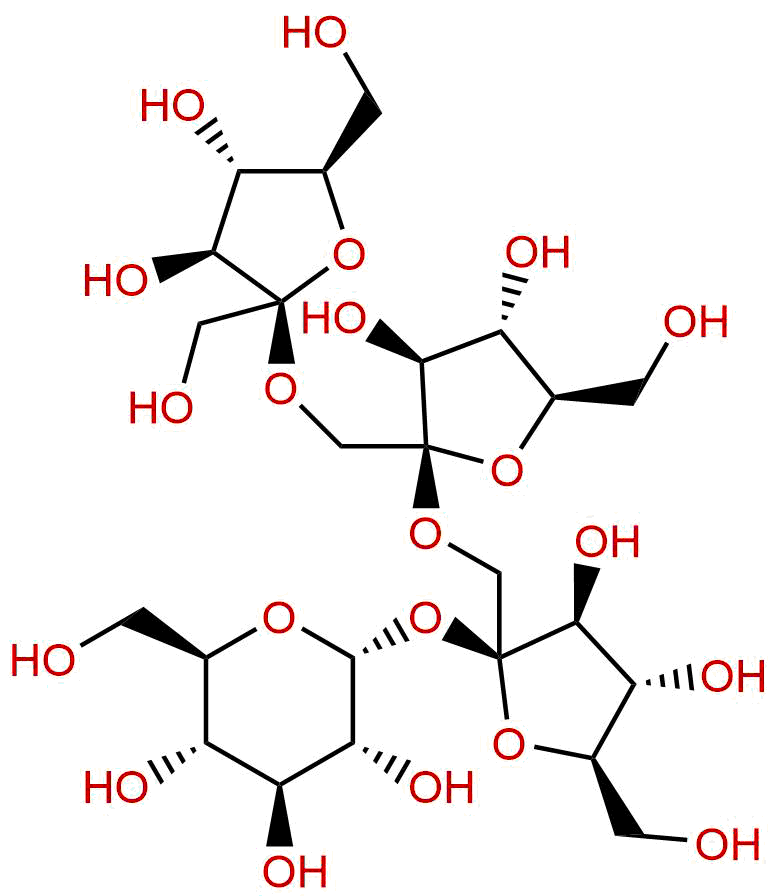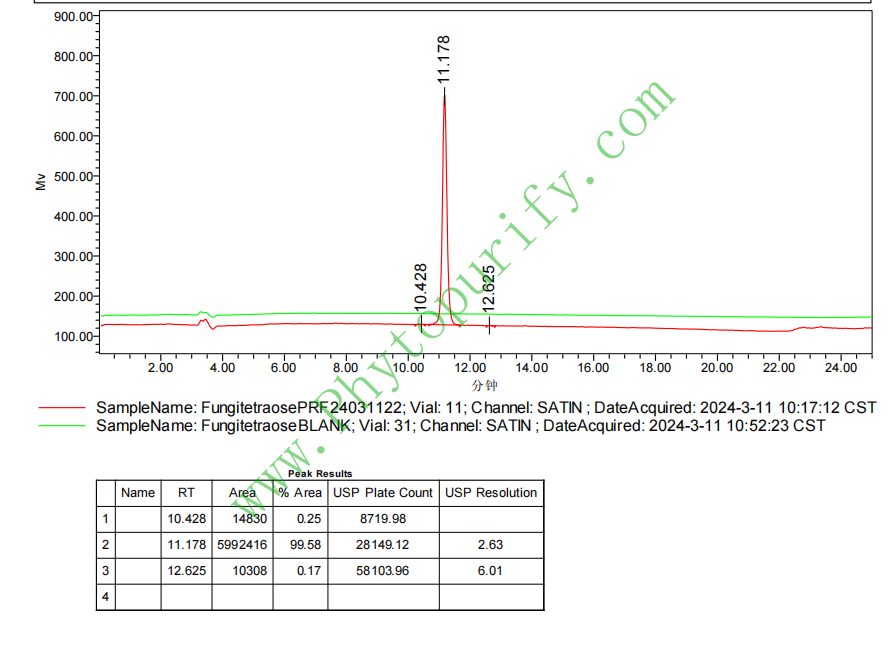
NystoseCAS No.:13133-07-8
|
||||||||||
 |
|
|
||||||||

| Catalogue No.: | BPF8574 |
| Formula: | C24H42O21 |
| Mol Weight: | 666.579 |
Product name: Nystose
Synonym name: Fungitetraose
Catalogue No.: BPF8574
Cas No.: 13133-07-8
Formula: C24H42O21
Mol Weight: 666.579
Botanical Source: Morindae Officinalis Radix
Physical Description:
Type of Compound: Miscellaneous
Purity: 95%~99%
Analysis Method: HPLC-DAD or/and HPLC-ELSD
Identification Method: Mass, NMR
Packing: Brown vial or HDPE plastic bottle
Storage: Store in a well closed container, protected from air and light. Put into refrigerate or freeze for long term storage.
The product could be supplied from milligrams to grams
Inquire for bulk scale.
For Reference Standard and R&D, Not for Human Use Directly.
Description:
Nystose has antioxidant capacity. Nystose and 1-Kestose can modulate the intestinal Microorganisms flora, a high content of kestose and nestose in the diet can cause a decrease in ileal and cecal pH (to 5.42 and 5.49, respectively)of turkeys, which may promote digestion.
References:
Int. J. Food Sci. Tech., 2014, 49(6):1500-5.
In vitro anti‐hydroxyl radical activity of the fructooligosaccharides 1‐kestose and nystose using spectroscopic and computational approaches
Fructooligosaccharides (FOS) are bioactive oligosaccharide fructans with beneficial health effects. Anti‐hydroxyl radical activity is an important factor in the description of antioxidant capacity of any natural product.
METHODS AND RESULTS:
The aim of this study was to estimate in vitro anti‐hydroxyl radical activity of the FOS 1‐kestose and Nystose by electron paramagnetic resonance spectroscopy (EPR) and fluorescence spectroscopy (FS) followed by a theoretical approach based on quantum chemistry calculations. A significant anti‐hydroxyl radical potential of both compounds was observed (72% and 78% by EPR and 69% and 74% by FS, respectively), indicating the Nystose to be a more active natural product. In addition, the computational results have confirmed that Nystose follows the same pattern previously shown for 1‐kestose, that is, that carbohydrates can react with hydroxyl radical.
CONCLUSIONS:
It is well known that FOS belong to cardioprotective nutraceuticals, so the study may be of some interest to research in heart disease.
Poult Sci. 2007 Jun;86(6):1133-9.
Effect of a kestose and nystose preparation on growth performance and gastrointestinal tract function of turkeys.
The aim of the present study was to determine the effects of dietary administration of a fructooligosaccharide preparation rich in kestose and nestose on growth performance and gastrointestinal parameters in young turkeys.
METHODS AND RESULTS:
The kestose and nestose preparation was obtained through bioconversion of sucrose using fungi fructosyl transferase and contained in DM 39.9% of kestose, 17.6% of Nystose, as well as 26.5% of glucose and 14.7% of sucrose. Three dietary levels of the sum of kestose and Nystose (0.3, 0.6, and 1.2%) were fed to growing turkeys for 8 wk. When compared with the control treatment, addition of the kestose and nestose preparation had no effect on feed intake, feed conversion, and BW. The kestose and nestose-supplemented diet, especially the medium level of kestose and Nystose, influenced microbial metabolism, especially in the ceca. Compared with the control group, the medium level of kestose and nestose decreased relative weight of gizzard (from 18.67 to 16.51 g/kg of BW) and weight of small intestine tissue (from 23.3 to 19.6 g/kg of BW) and increased weight of ceca digesta (from 3.51 to 4.77 g/kg of BW) as well as activities of microbial beta-glucosidase (an increase from 0.22 to 0.38 U/g) and alpha-galactosidase (an increase from 0.90 to 1.61 U/g), pH of digesta (a decrease from 6.13 to 5.79), concentration of NH3 (an increase from 0.60 to 0.98 mg/g), and concentration of total short-chain fatty acids (an increase from 81.1 to 107.7 micromol/g) in the cecal digesta. A high content of kestose and nestose in the diet caused a decrease in ileal and cecal pH (to 5.42 and 5.49, respectively).
J. Appl. Glycosci., 2006, 53(3):175-80.
Effects of 1-Kestose and Nystose on the Intestinal Microorganisms and Immune System in Mice.
METHODS AND RESULTS:
We investigated the effects of the major short chain fructooligosaccharides, 1-kestose and Nystose, on the intestinal microorganisms and on the intestinal and systemic immune responses of mice. Both 1-kestose and Nystose promoted intestinal Lactobacillus number. However, the balance of Lb. reuteri and Lb. intestinalis, the major Lactobacillus species in the mice was not altered. The IgA content in the feces of mice treated with both 1-kestose and Nystose increased from day 4 to day 7 after starting the administration and returned to the same level of control mice on day 14. Splenocyte responses to Con A, anti-CD3 plus anti-CD28 antibodies and LPS were reduced by 1-kestose and Nystose. Nystose lowered IL-2, IFN-γ, IL-12 and IL-4 secretion from the splenocytes more than 1-kestose.
CONCLUSIONS:
These results suggested that both 1-kestose and Nystose can influence the microorganisms as well as the intestinal and systemic immune responses, but to different degrees.
HPLC of Nystose
